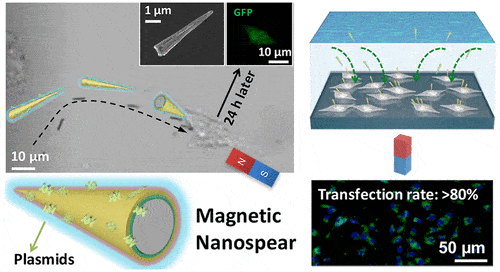Researchers have recently developed remote-controlled, needle-like nanospears capable of piercing membrane walls and delivering DNA into selected cells. This new technology allows biological materials to be transported throughout the body with pinpoint accuracy, thus making gene alteration a simpler and more effective procedure.
Genetically modified cells are now used in stem cell and cancer research, but the production of such cells is rather costly and inefficient, often including viruses, harsh chemical reagents or external electrical fields.
In the past, researchers used sharp-tipped nanoparticles stuck to surfaces in order to deliver molecules to cells, but removing the altered cells from the nanoparticle-coated surface was difficult. Other techniques involved self-propelled nanoparticles, but controlling them was not easy. In addition, mobile nanoparticles can generate toxic byproducts.
A team of scientists from the University of California, Los Angeles, wanted to make the process more efficient, so they developed biocompatible nanospears that can accurately transport biological material via an external magnetic field. In this way, cells are safe from damage and the use of chemical propellants is no longer necessary.
Authors Steven J. Jonas, Paul S. Weiss, Xiaobin Xu and colleagues fabricated nanospears using templates made of polystyrene beads. They put the beads on a silicon structure and etched them down into a sharp spear shape. After the beads’ removal, they coated the resulting silicon spears with thin layers of nickel and functionalized gold, so that biomolecules, such as DNA, could attach.
Next, the team scraped the nanospears from the silicon. Thanks to the magnetic nickel layer, scientists could accurately control the particles’ movements and orientation. Then, researchers tested their invention in a lab dish, where the nanospears had to deliver DNA to brain cancer cells. The cancerous cells were altered so that they would express a green fluorescent protein.
Researchers were pleased with the results: more than 90% of the cells remained viable, and more than 80% exhibited green fluorescence. The results also showed that this method was less harmful and more effective than other non-viral ones. The authors believe that this technique might lead to new ways to prepare vast numbers of cells for the coordinated manufacture of gene therapies.
The paper was published today in the journal ACS Nano.


